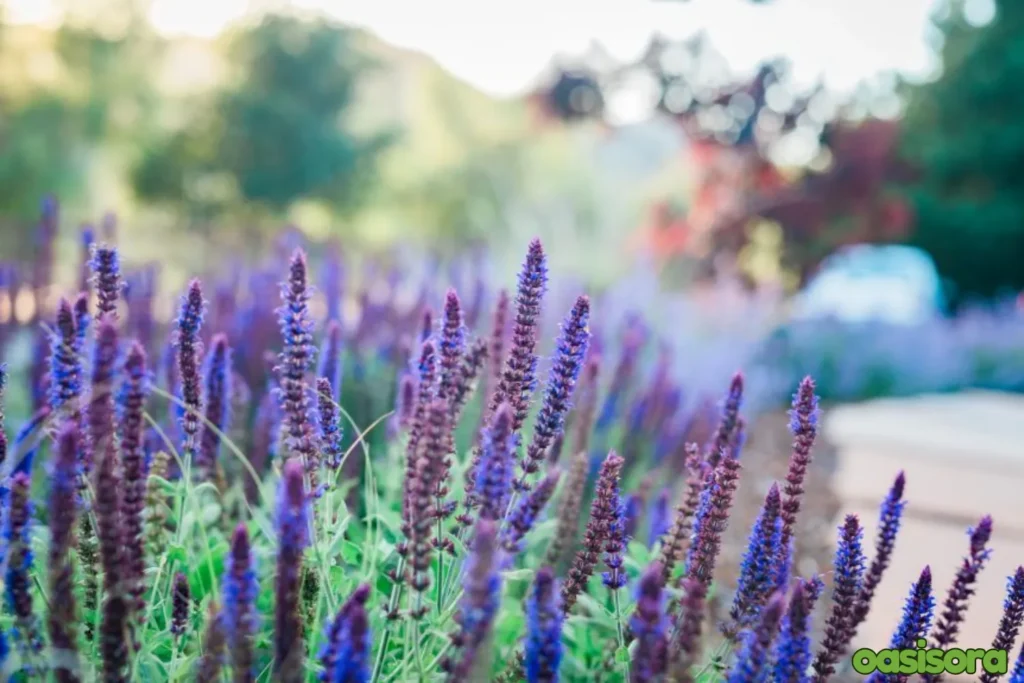
Creating a beautiful, low-maintenance yard in California doesn’t have to come at the cost of high water bills or constant upkeep. With drought-resistant plants, homeowners can design landscapes that thrive in dry conditions while conserving water and supporting sustainable gardening practices. These hardy plants are well-suited for California’s climate, offering long-term savings, resilience, and natural beauty with minimal watering.
That’s a very good thing! Plus, drought-tolerant landscaping is an eco-friendly and wiser choice for homes and communities in cities enforcing water restrictions.
So, today let’s examine the best drought-resistant plants for California yards along with their key features and perks. So, stay tuned!
Why Drought-Resistant Plants Are Essential for California Yards
The drought-resistant plants for California yards not only bring a splash of hue and texture to the garden but also reduce water waste and thrive with minimal watering:
Here are three key reasons why drought-resistant plants are a must-have for California yards:
1. Water Conservation
You will be surprised to hear that traditional gardens can use almost half of your household’s water supply. Making the switch to drought-resistant plants can save you a ton of money and water! It’s also an easy method to help the environment and go green. These incredible plants are truly water savers!. They help reduce water waste by requiring less frequent watering.
2. Climate Resilience
For plants, California’s dry environment and periodic droughts can be very challenging. The drought-resistant plants, on the other hand, are made to survive in challenging environments.
3. Low Maintenance
Ditch the gardening stress! Drought-Resistant plants for California yards are too simple to care for. They are perfect for busy people, they thrive with minimal watering and upkeep. So, Just plant, relax, and enjoy!
Plus, my folks: Low Maintenance = Additional Free Time for You….ha-ha
So, incorporate drought-resistant plants into your yard today to support water conservation and create a stunning, low-maintenance outdoor space.
Top 30 Drought-Resistant Plants for California Yards
Drought-resistant plants are a perfect solution for California landscaping, offering a beautiful and water-efficient way to enhance your home’s exterior. Here is a list of 30 incredible drought-resistant plants that can offer you the prettiest and minimal care water-efficient yard:
Trees
Firstly, let’s discuss drought-resistant trees with the main varieties:
1. California Mountain Lilac (Ceanothus spp.)

California Lilac
| Size: | 3 to 6 feet |
| Ideal Zones: | 7 to 10 |
| Type: | Perennial Evergreen Shrub |
| Notable Feature: | Blooms in the winter and spring |
Also known as Ceanothus spp, Wild Lilac, or Blue Blossom, the California Mountain Lilac is a low-maintenance evergreen bush that tolerates different soils. It hates rich potting soil and excessive watering and needs really low maintenance. Busy individuals will love this bush. It’s too good for people who don’t want to invest a lot of time in gardening. It’s also great for people who are new to gardening. This lilac’s fragrant blooms and emerald leaves make it more beautiful for any yard.
Also because it is an evergreen, it is excellent for areas that require less water and a little color throughout the year.
2. Big Berry Manzanita (Arctostaphylos glauca)
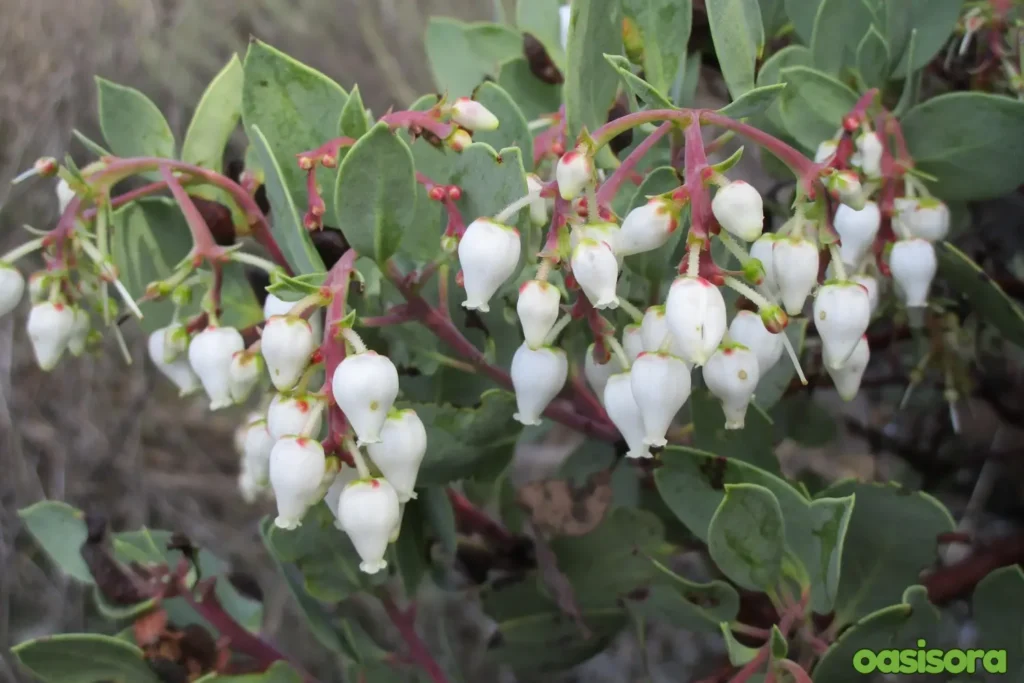
Big Berry Manzanita
| Size: | 3 to 20 feet |
| Ideal Zone: | 7 to 10 |
| Type: | An Evergreen Plant |
| Notable Feature: | Winter and spring flowers |
Known as Arctostaphylos glauca, Big Berry Manzanita is a large evergreen shrub or small tree. It has light gray-green leaves and produces white flowers in spring. The flowers attract hummingbirds and insects. The plant also produces edible, light red fruit that attracts wildlife. It’s a slow-growing plant that can live up to 100 years.
Plus, it grows 3 to 20 feet tall and 6 to 20 feet wide with twisting branches and smooth red bark. Although it thrives inland, it grows larger by the coast, which is its natural environment. It grows larger along the coastline (its native habitat) but still performs well inland.
3. Western Redbud (Cercis occidentalis)
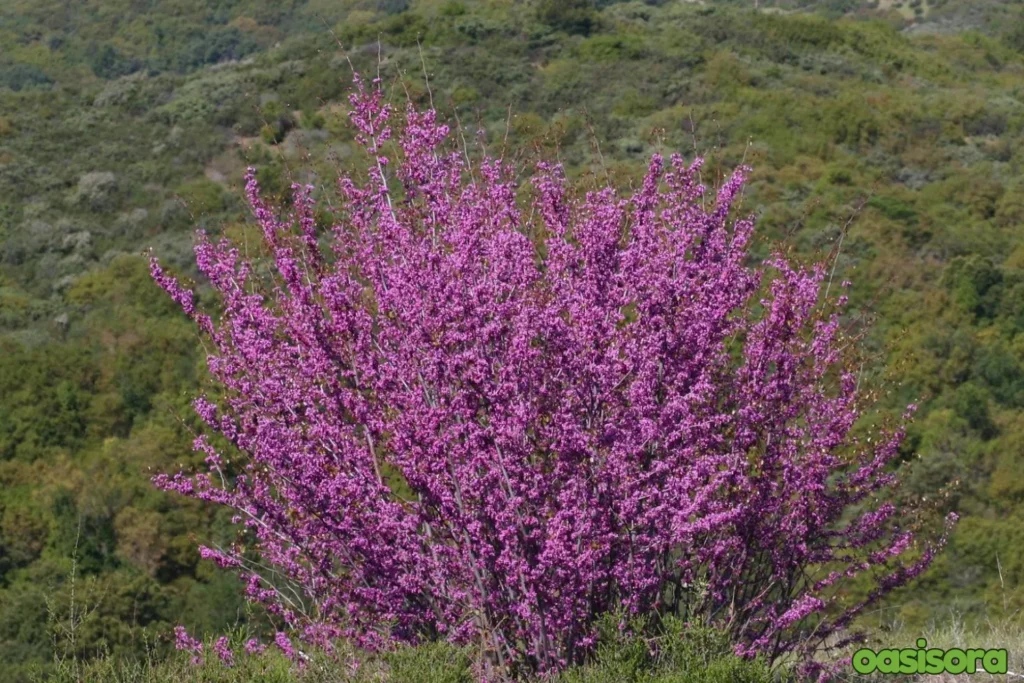
Western Redbud
| Size: | Up to 20 feet tall and 10 feet wide |
| Ideal Zone: | USDA zones 6-9 |
| Type: | Deciduous shrub or small tree |
| Notable Feature: | Vibrant pink purplish flowers in spring |
Another drought-resistant plant for California yards is Western Redbud. Aka California redbud, this remarkable purple-lavender colored tree is a must-have for everyone to boost the yard’s beauty. It usually blooms in spring with vibrant magenta flowers. Hummingbirds, bees, and butterflies adore them. Summer brings long, purple-brown seed pods on this plant to create a twice-blooming illusion that looks effortlessly chic! .
The fresh apple-green leaves turn blue-green, then golden yellow and rusty red in fall. As leaves fall, the tree’s beautiful silver shape appears. This compact Western Redbud is great for small gardens and shines in every season.
4. Chilean Mesquite (Prosopis chilensis)
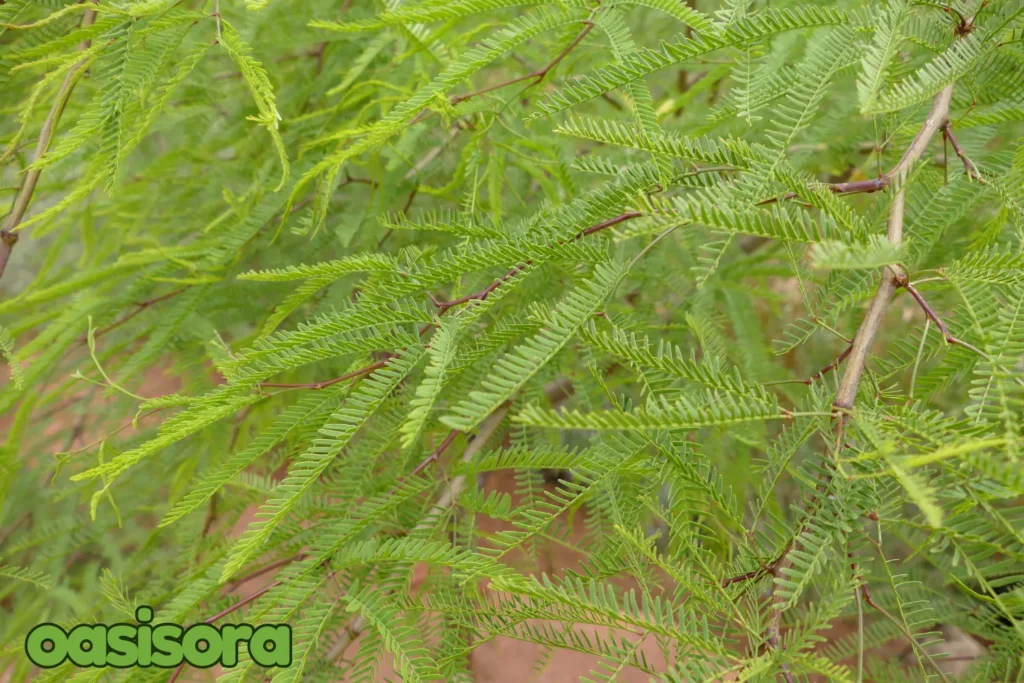
Chilean Mesquite
| Size: | Up to 50 feet tall and 30 feet wide |
| Ideal Zone: | USDA zones 8-11 |
| Type: | Deciduous tree |
| Notable Feature: | Beautiful shade, fragrant flowers |
The Fabaceae family includes the medium-sized Chilean mesquite tree. It grows in Argentina’s and Chile’s Andes Mountains. The tree has thick, waxy leaves for water storage. Small, white flowers bloom, this amazing tree grows up to 3 feet approx and thrives in rocky areas with good drainage. Plus, Neltuma chilensis is also a useful and versatile tree. It offers firewood and shade. This tree boasts nutrient-dense seeds that are used in animal feed, and its leaves are food for animals.
Plus, the tree’s blossoms are pollinated by bees, notably honey bees.
5. Fruitless Olive (Olea europaea ‘Swan Hill’)
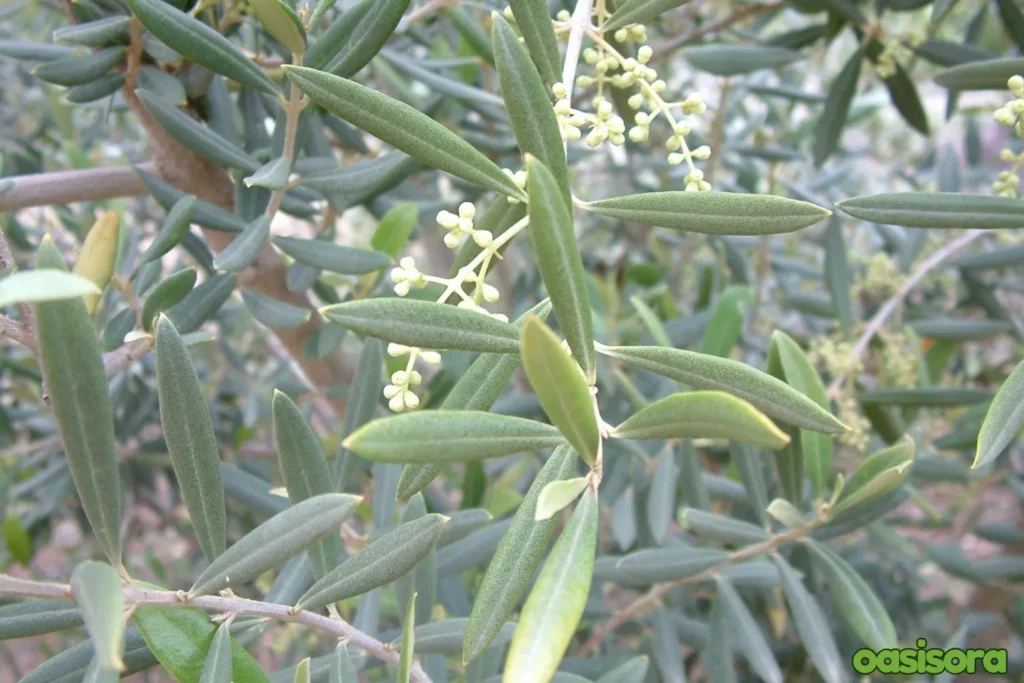
Fruitless Olive
| Size: | Up to 15 feet wide & 25 feet tall |
| Ideal Zone: | USDA zones 9-11 |
| Type: | Evergreen tree |
| Notable Feature: | Attractive, silver-green foliage and no fruit production |
Want a chic olive tree in your yard? Then, plant the “Swan Hill” or olive tree in your yard. Such drought-resistant plants for California yards boast slender, grey-green leaves with a silvery underside. It grows slowly and responds well to pruning. If left unpruned, it grows as tall as it is wide. Plus, the bark of this tree is pale grey.
It bears white flowers in the spring, but it often bears fruit because the blossoms are usually infertile. Once planted, this hardy tree can withstand drought.
Shrubs
Ultimately, now we are going to read about top drought-resistant shrubs:
6. White Sage (Salvia apiana)
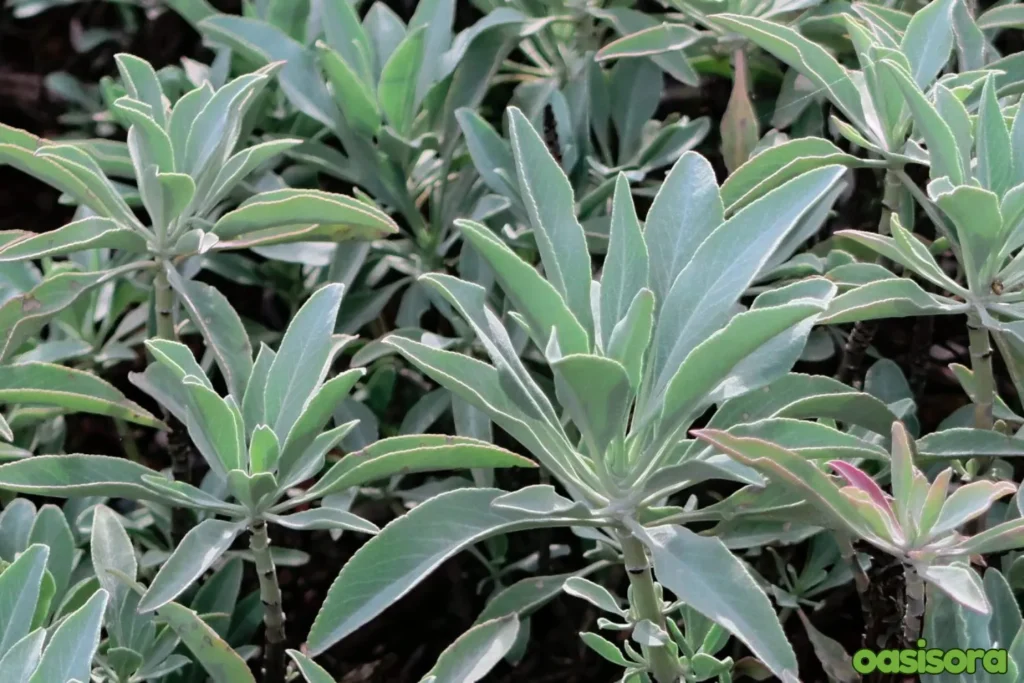
White Sage
| Size: | 3-5 ft. |
| Ideal Zone: | 8-11 |
| Type: | Perennial evergreen sub-shrub |
| Notable Feature: | Fragrant, silvery-gray leaves |
One of the most vital Salvia species in Southern California is White Sage(aka White Sage, California Sage, Bee Sage, and Sacred Sage), which is native to the coastal sage scrub region of the state. The Silver-white leaves and clusters of lavender-streaked white blooms are remarkable characteristics of it. Plus, its Young leaves are initially green, but as they mature, they turn a whitish shade. These cute, tiny purplish-white flowers bloom late in April, thus making them an attraction point for bees or butterflies. That’s why it is used in wildlife gardens.
In traditional medicine, white sage is utilized in various ways. This plant is truly an excellent and useful plant for so many reasons!!
7. California Wild Rose (Rosa californica)
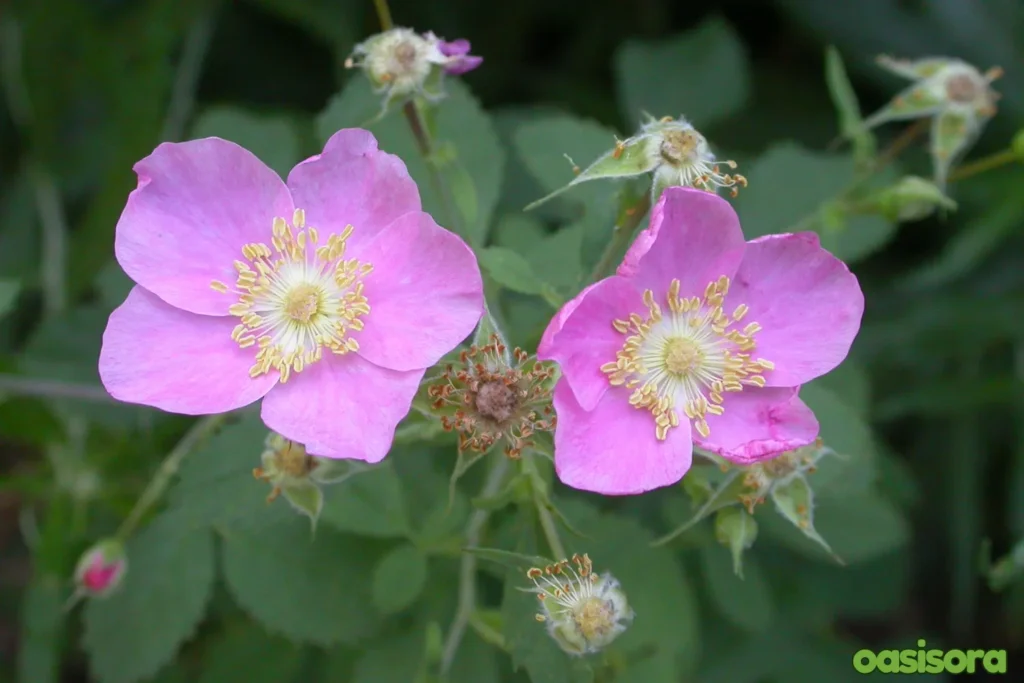
California Wild Rose
| Size: | 3-6 ft. tall, 6-8 ft. wide |
| Ideal Zone: | 5-9 |
| Type: | Deciduous shrub |
| Notable Feature: | Fragrant, pink to purple flowers |
California wild rose, California rose, or Wood’s rose is indeed a beautiful native plant. It’s pretty pink flowers usually bloom in spring or summer, attract butterflies or other helpful insects to the yard, and also they smell nice. In the fall, it boasts red berries eaten by birds.
Plus, this plant is too easy to grow. It can live with little water, but you have to offer it extra water in the summer. This plant grows well in many types of soil and can be used as a barrier plant. Also, it needs a little pruning to keep it small.
8. Toyon (Heteromeles arbutifolia)

Toyon
| Size: | 6-15 ft. tall, 8-12 ft. wide |
| Ideal Zone: | 8-11 |
| Type: | Evergreen shrub or small tree |
| Notable Feature: | Bright red berries, attractive foliage |
Friends….do you desire a beautiful and low-maintenance shrub for your yard? Toyon is a great choice for you then!. The leaves of this little shrub are light greenish at the bottom and dark green at the top. That gives it a pleasant look. It attracts a lot of birds and other wildlife with its rich red berries that are produced in the fall and endure all winter.
Hence, a straightforward drought-resistant plant that supplies food and shelter for creatures must be what every garden needs: Toyon.
9. Hopseed (Dodonaea viscosa)
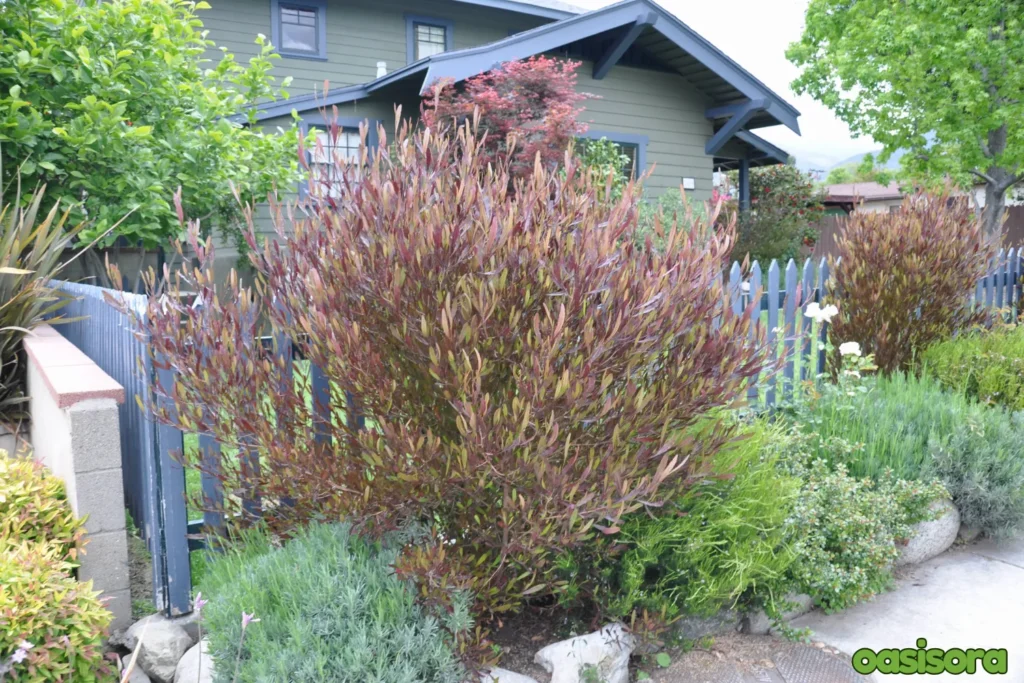
Hopseed
| Size: | 10-15 ft. tall, 8-12 ft. wide |
| Ideal Zone: | 9-11 |
| Type: | Evergreen shrub or small tree |
| Notable Feature: | Attractive foliage, hop-like seed pods |
People like the Hopseed (Dodonaea viscosa) because of its special three-winged fruits. Such Drought-Resistant Plants for California Yards are fast-growing bushes with many stems and shiny green leaves. The leaves are sticky and resin-like, which helps this bush save water plus gives it a varnished look. This means it can survive with very little water. Plus, its small yellow flowers appear in spring, followed by colorful seed pods in summer and fall.
The seed pods start green and then turn yellow, pink, and red.
10. Oleander (Nerium oleander)

Oleander
| Size: | 6-12 ft. tall, 4-8 ft. wide |
| Ideal Zone: | 8-11 |
| Type: | Evergreen shrub |
| Notable Feature: | Showy, fragrant flowers in shades of pink, red, and white |
Oleander- a plant with a toxic twist!! An evergreen shrub that dwells in warm climates and has prettiest showy flowers of several colors, like: pink, white, red, and yellow, that are used in cultivation. These sparkling flowers bloom in spring through fall and delight the yards with their beauty. Its leaves have a lovely green color that contributes to the atmosphere of the tropical region, too. But a little caution here…
All parts of the oleander are poisonous, so be careful with it around children and pets. With proper care, this shrub is an excellent addition to gardens that’s hardy and versatile and looks marvelous.
Ground Covers
Now, let’s examine the prevalent ground cover plants:
11. Lantana (Lantana camara)
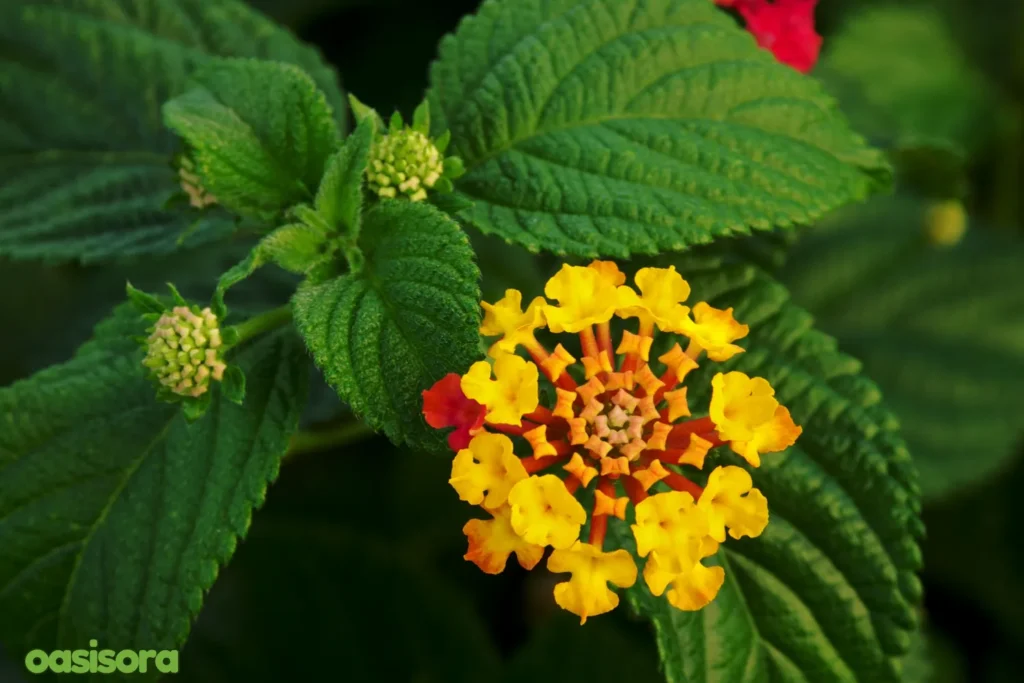
Lantana
| Size: | 3-6 ft. tall, 6-8 ft. wide |
| Ideal Zone: | 9-11 |
| Type: | Evergreen ground cover shrub |
| Notable Feature: | Clusters of small, fragrant flowers in shades of pink, yellow, orange, and purple |
Lantana camara (known as Lantana) is a beautiful flowering shrub. Native to the Americas, this has now spread to all corners of the world. It is popular mainly as a garden plant because it is easy to grow and produces many tiny, good-smelling flowers in several different colors: pink, yellow, orange, and purple. They grow in clusters, making this cover look really stunning. Lantana also attracts birds and pollinators, which makes it one of the awesome choices for a wildlife yard.
They are drought-tolerant and heat-tolerant, hence a low-care plant. Overall, such ground covers can be wonderful drought-resistant plants in California yards.
12. Myoporum (Myoporum parvifolium)
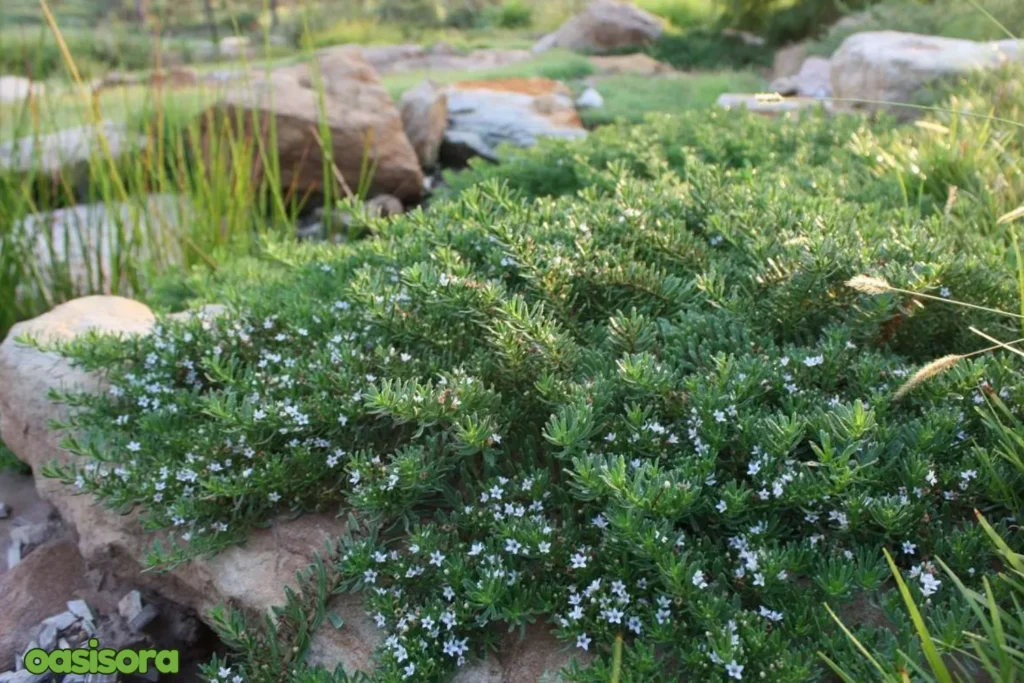
Myoporum
| Size: | 3-6 ft. tall, 8-12 ft. wide |
| Ideal Zone: | 9-11 |
| Type: | Evergreen groundcover or shrub |
| Notable Feature: | Tiny white flowers in summer, followed by purple berries, and delicate, almost prostrate stems |
Myoporum parvifolium or Creeping Myoporum, is a fast-growing pretty ground cover with dense foliage. It has tiny white star-shaped flowers with purplish little spots in the summer season and gentle stems that evenly spread out around the plant with four stamens extending beyond its petals. This plant is so easy to care for and can grow in tough spots. It’s also good at handling drought and foot traffic. As it is extremely hardy ground cover, so mainly used for:
- Embankments
- Verges
- Streetscapes
- High Traffic Areas.
13. Deer Grass (Muhlenbergia rigens)
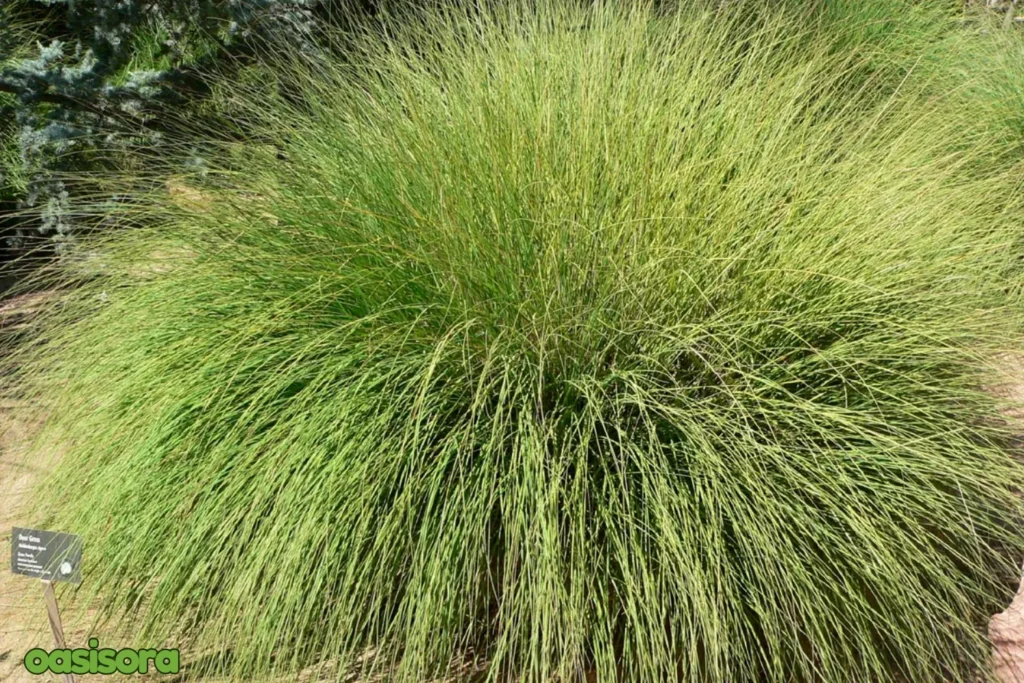
Deer Grass
| Size: | 2-3 ft. tall, 1-2 ft. wide |
| Ideal Zone: | 4-9 |
| Type: | Ornamental ground cover |
| Notable Feature: | Slender, blue-green foliage and delicate, feathery plumes in shades of purple and gold |
Deer Grass is one of the prevalent types of Drought-Resistant Plants for California Yards. It’s a pretty grass that grows in bunches. Its leaves are thin and pointy, and they offer a greenish or silver-green color. They stand up straight at first as young but bend down as they grow, making a nice shape. In the fall, the leaves turn a light brown color. Plus, the grass grows flowers that are yellow or purple, and they can grow to a good height!.
Deer Grass grows very fast and also helps animals, birds, and mammals. But deer don’t like to eat it, and People used to use the flower stems of it to make baskets.
14. California Poppy (Eschscholzia californica)
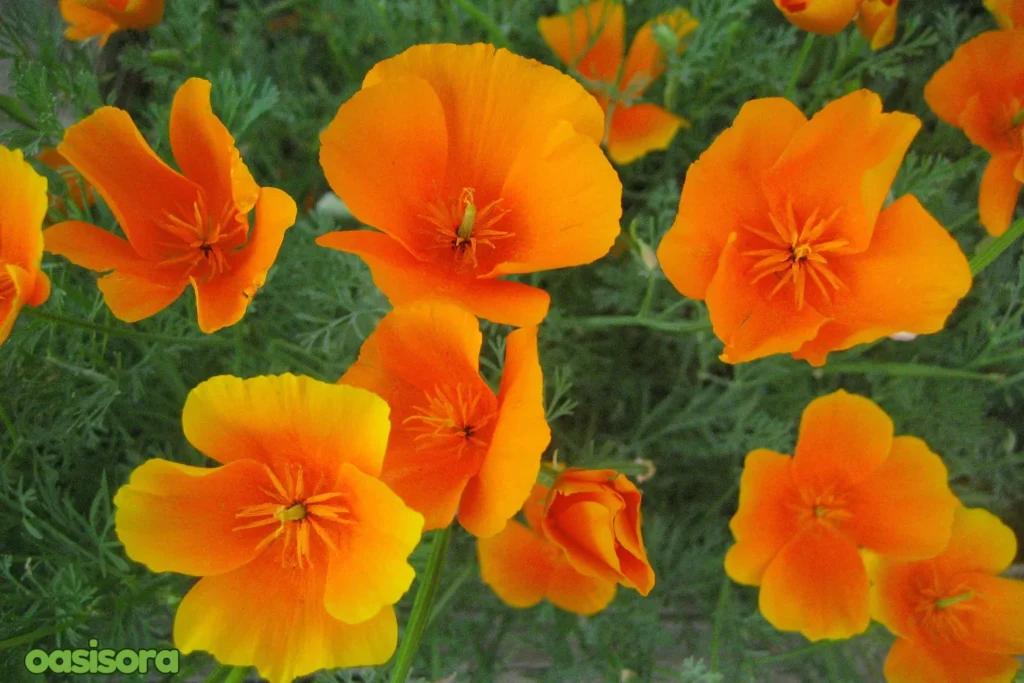
California Poppy
| Size: | 12-18 in tall, 12-18 in wide |
| Ideal Zone: | 9-11 |
| Type: | Perennial flower type ground cover |
| Notable Feature: | Bright orange, cup-shaped flowers with delicate, tissue-paper-like petals and a golden center |
Want a pretty ground cover with orange flowers THAT lightens up YOUR YARD? Then, choose the California poppy- which is also called the Golden Poppy, California Sunlight, Cup of Gold, or Golden Cup. This flower requires very little water and grows fast. It’s an ideal plant for your dry desert-type regions.
They are regarded as special as they are also the state flower of California that comes in many colors, such as pink, orange, and yellow. So, pick your favorite hue and grow it in your backyard! Its flowers open at daytime and close at night.
- Yarrow (Achillea millefolium)
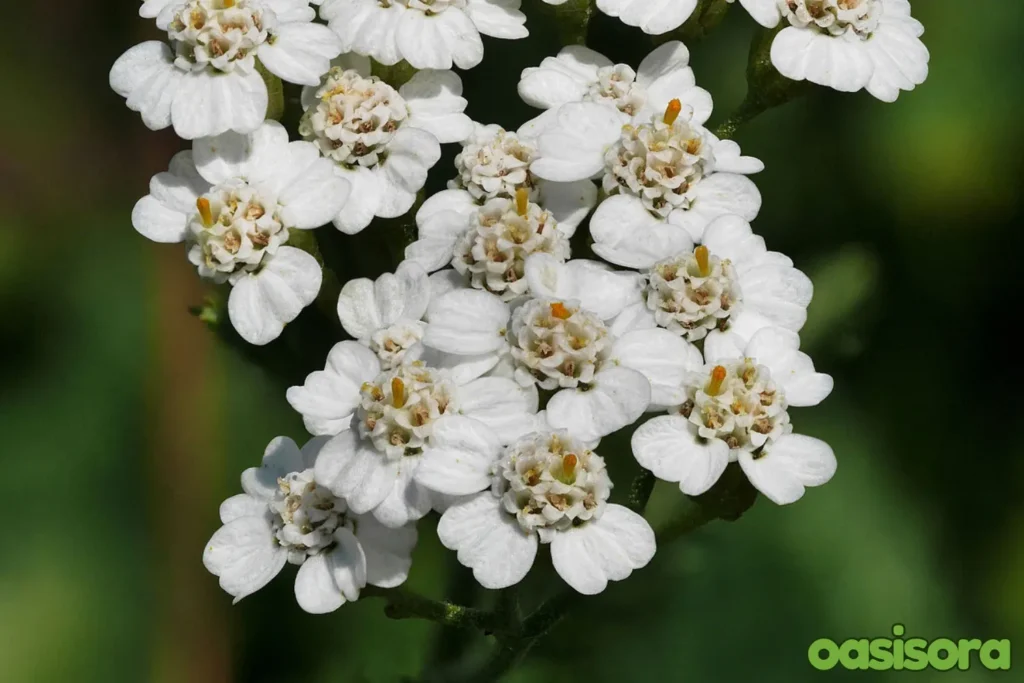
Yarrow
| Size: | 2-4 ft. tall, 1-3 ft. wide |
| Ideal Zone: | 3-9 |
| Type: | Lasting ground cover |
Notable Feature: | Fern-like foliage and flat-topped clusters of small, white, or yellow flowers that attract butterflies and bees. |
Dream of a beautiful flower to attract butterflies and bees to your yard? Choose yarrow, then! Known by several names, including Yarrow, Western Yarrow, Yarrow, and Milfoi, this everlasting flower displays lovely yellow or creamy-white blossoms in flat clusters. This plant can thrive in a variety of soil types and is far too easy to maintain. It is ideal for regions with warm summers and cold winters. Further, it stops erosion and maintains overall soil health.
Being a fantastic addition to your yard, yarrow is a favorite of bees and butterflies.
Succulents & Cacti
So, now let’s talk about something cacti!! The drought-resistant cacti and succulents:
16. Yucca (Yucca whipplei)
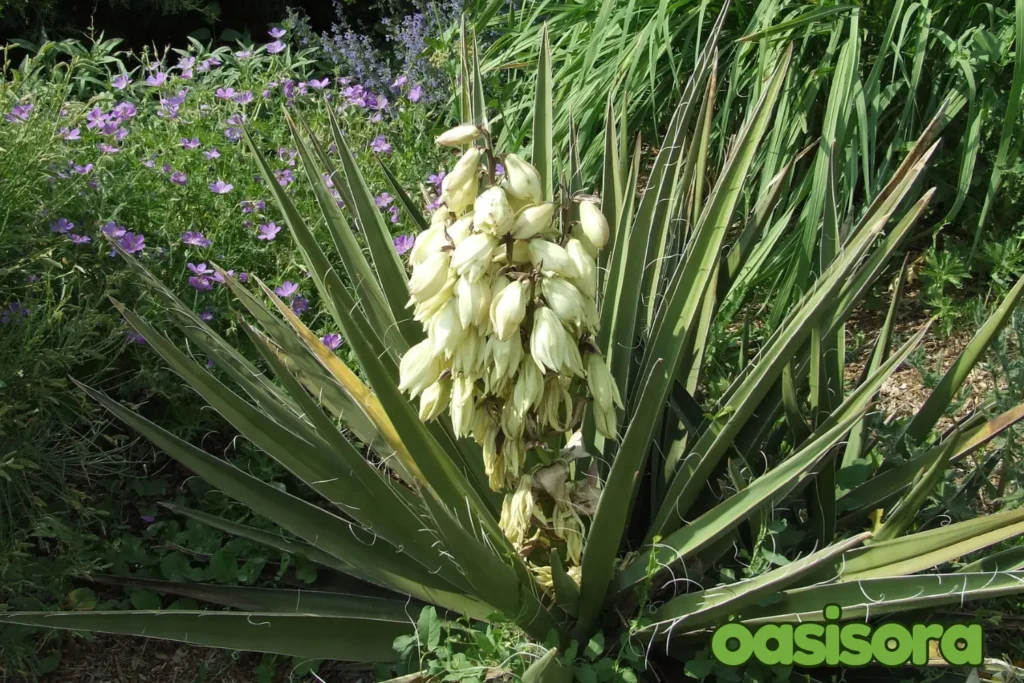
Yucca
| Size: | 3-6 ft. tall, 3-6 ft. wide |
| Ideal Zone: | 6-10 |
| Type: | Evergreen cacti |
| Notable Feature: | Tall stalks of white or purple flowers and sharp, sword-shaped leaves. |
If you’re looking for a great plant for the yard, then try Yucca! It is a strong shrub, greenish with sharp-pointed leaves in springtime complementing the big white flowers. The Yucca is a great specimen plant because it requires very little moisture and is not favored by deer. It thrives effortlessly and looks great with minimal care. Also, Yucca is planted by lots of people in their gardens because of its beauty and unbeatable strength.
Yuccas are also great for decorating gardens! And guess what? Some parts are edible, too! It can provide edible fruits, seeds, flowers, and edible flower stalks. Sometimes, you can even eat its roots! So, why not give it a try?
17. Agave (Agave shawii)
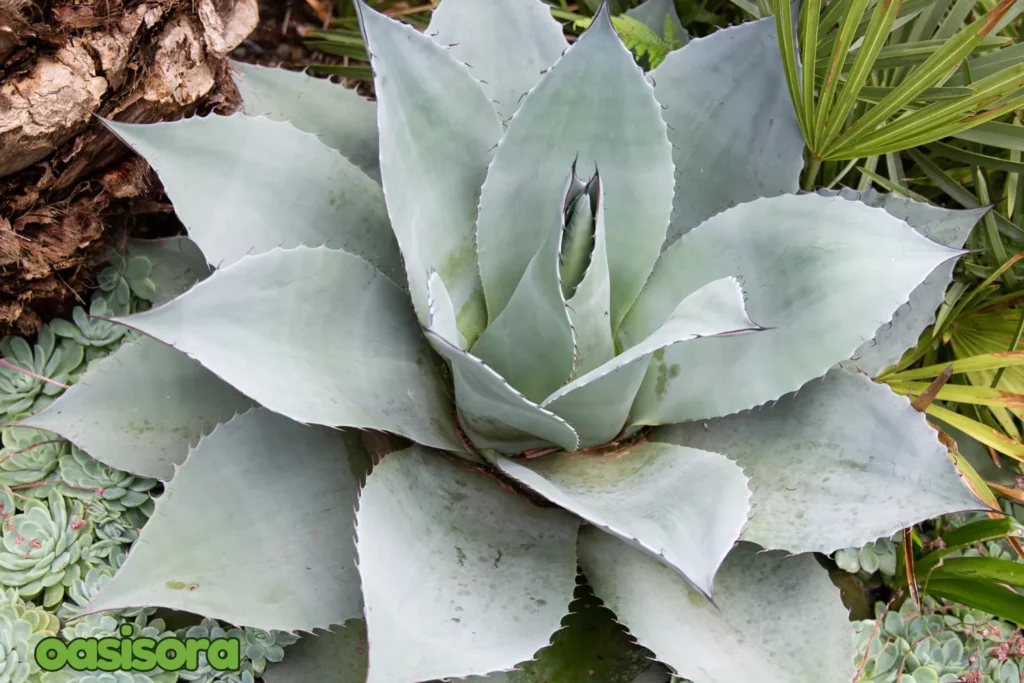
Agave
| Size: | 3-6 ft. tall, 4-6 ft. wide |
| Ideal Zone: | 9-11 |
| Type: | Succulent |
| Notable Feature: | Large, fleshy leaves with sharp spines and a tall flower stalk with greenish-yellow flowers. |
Shaw’s agave is a special succulent plant. It has round, shiny, green leaves with teeth. After growing slowly, it grows a big bunch of flowers. Then, the main plant dies. But don’t worry, drought-resistant plants for California yards grow many new baby plants around it. Agave is usually used for decoration, medicine, and in the creation of sweeteners, syrups, etc. Its extract is also used in many skincare products for moisturizing and soothing the skin.
18. Cacti (Cylindropuntia spp.)
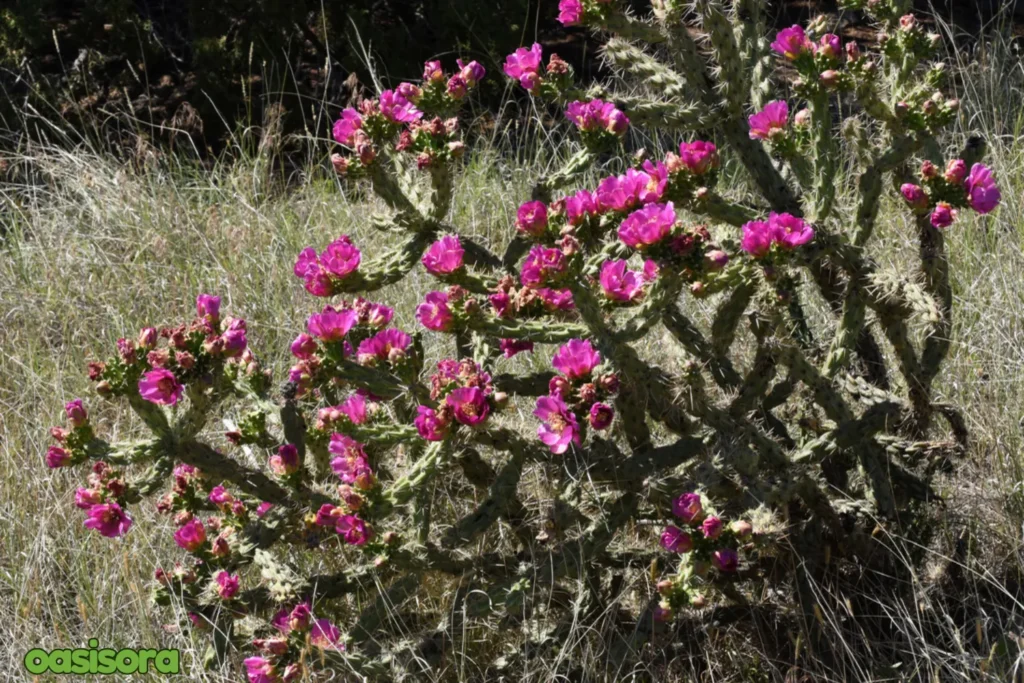
Cacti
| Size: | 3-10 ft. tall, 6-12 ft. wide |
| Ideal Zone: | 9-11 |
| Type: | Succulent |
| Notable Feature: | Round, cylindrical stems covered in sharp, barbed spines and vibrant flowers in shades of pink, yellow, and red. |
Big and wide types of cactus, including Cylindropuntia, differ in their constructions, having segmented cylindrical stems that take the forms of miniature trees. Its stems are round and overall covered with sharp spines. Beautiful flowers of it include pink, yellow, and red. The cactus prefers full sun and dry soil. It’s great for hot gardens. It’s also called cholla cactus.
19. Chalk Liveforever (Dudleya pulverulenta)
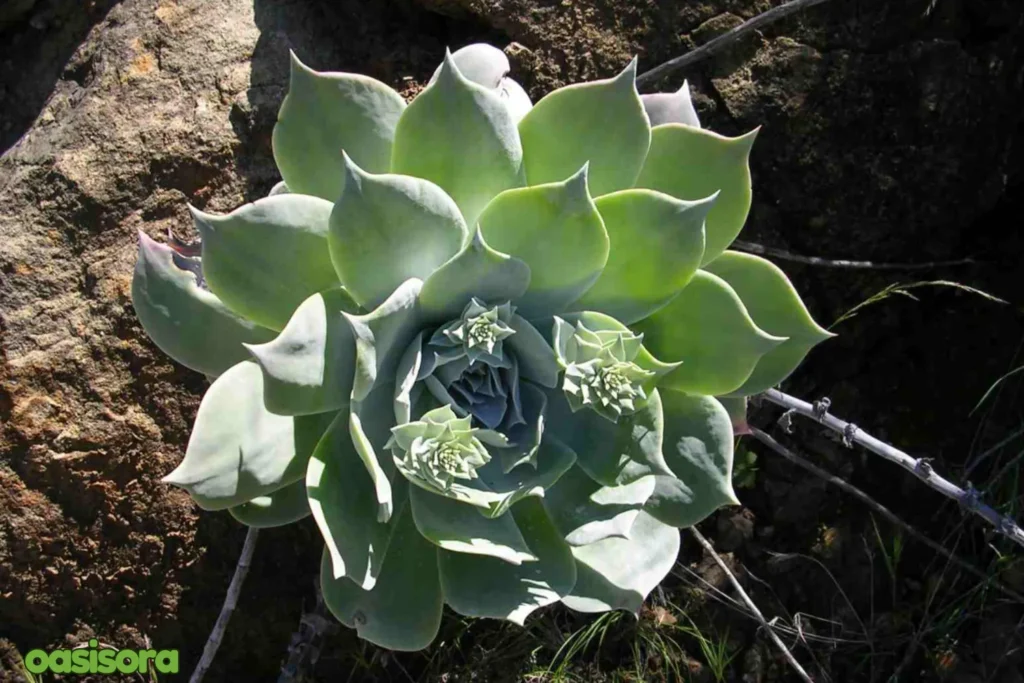
Chalk Liveforever
| Size: | 6-18 in tall, 8-12 in wide |
| Ideal Zone: | 9-11 |
| Type: | Succulent |
| Notable Feature: | Thick, powdery leaves with a silvery sheen and tall stalks of white or pink flowers. |
Chalk Liveforever is a pleasant succulent with silvery, powdery leaves. In the spring, this plant produces magnificent white or pink flowers. It is, thus, a great addition to rock gardens and dry spots. Plus, It requires low care and maintenance and is good for containers growing indoors. Furthermore, it is a favorite of gardeners who want to attract bees and butterflies!
20. Pineapple Palm (Phoenix canariensis)
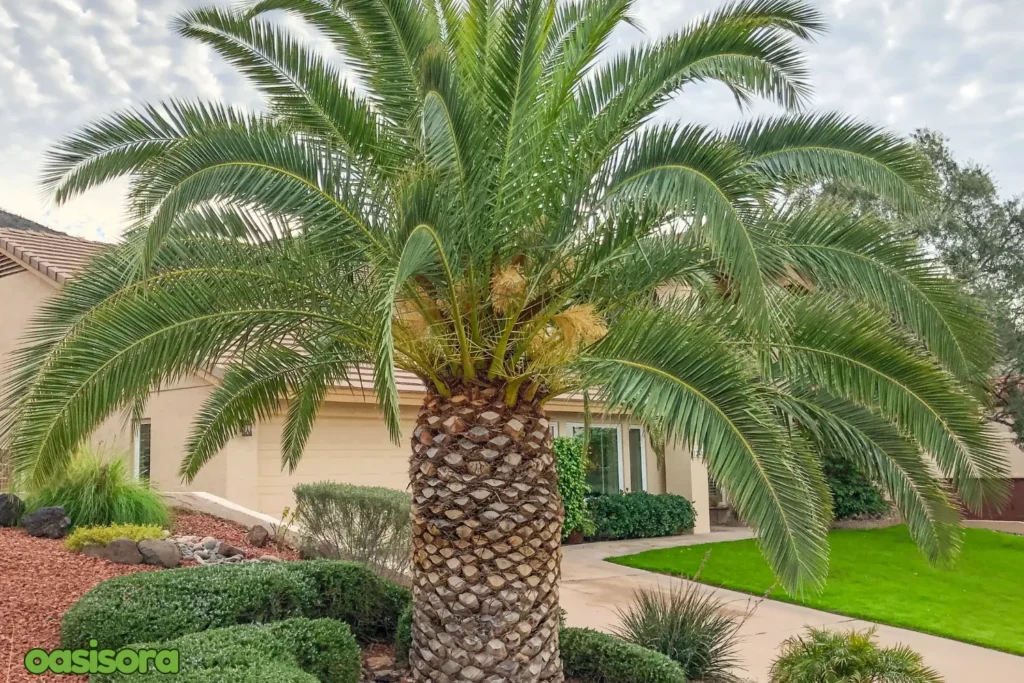
Pineapple Palm
| Size: | 40-60 ft. tall, 15-20 ft. wide |
| Ideal Zone: | 9-11 |
| Type: | Evergreen tree/palm |
| Notable Feature: | Large, spreading canopy, edible pineapple-like dates, and a sturdy trunk with diamond-shaped patterns. |
The pineapple palm tree is enormous and stunning!. Like a large umbrella, its enormous canopy spreads out widely. Its trunk is super strong and has cool diamond patterns on it. The best part? It produces yummy, sweet dates that you can eat! Since they appear quite pretty, people prefer to plant them in parks, gardens, and public areas. You might even spot one in your neighbor’s yard if you live in a warm climate!
Flowering Perennials
Now, let’s explore the best flowering or perennials drought-resistant plants for California yards:
21. Hummingbird Sage (Salvia spathacea)
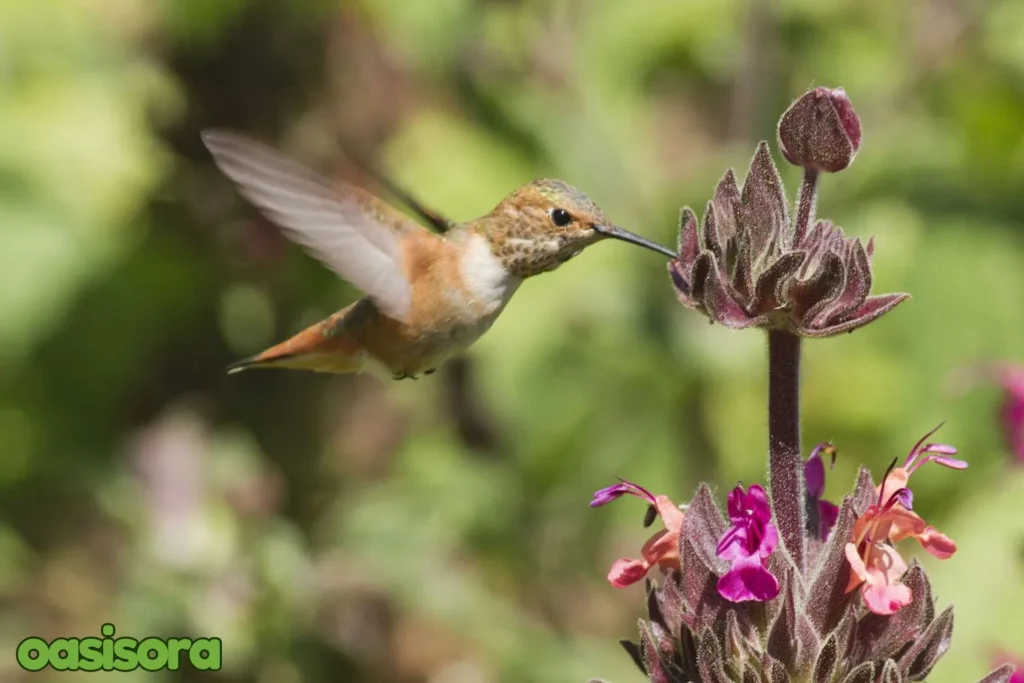
Hummingbird Sage
| Size: | 1-3 ft. tall, 3-5 ft. wide |
| Ideal Zone: | 8-11 |
| Type: | Perennial |
| Notable Feature: | Attractive flowers, pleasant scent, and fragrant foliage that attracts hummingbirds |
Hey there, my young adventurous gardeners! Do you know hummingbirds love and adore Hummingbird Sage? It’s due to its look that allures pollinators, butterflies, and these cute birds…. Its striking pink and scarlet flowering spikes and delicious scent make this pretty sage shine. It is a common groundcover plant because it spreads by rhizomes and eventually covers an immense area.
It’s also simple to care for and can grow in shady spots with little water. That’s so cool!
22. Scarlet Bugler (Penstemon centranthifolius)
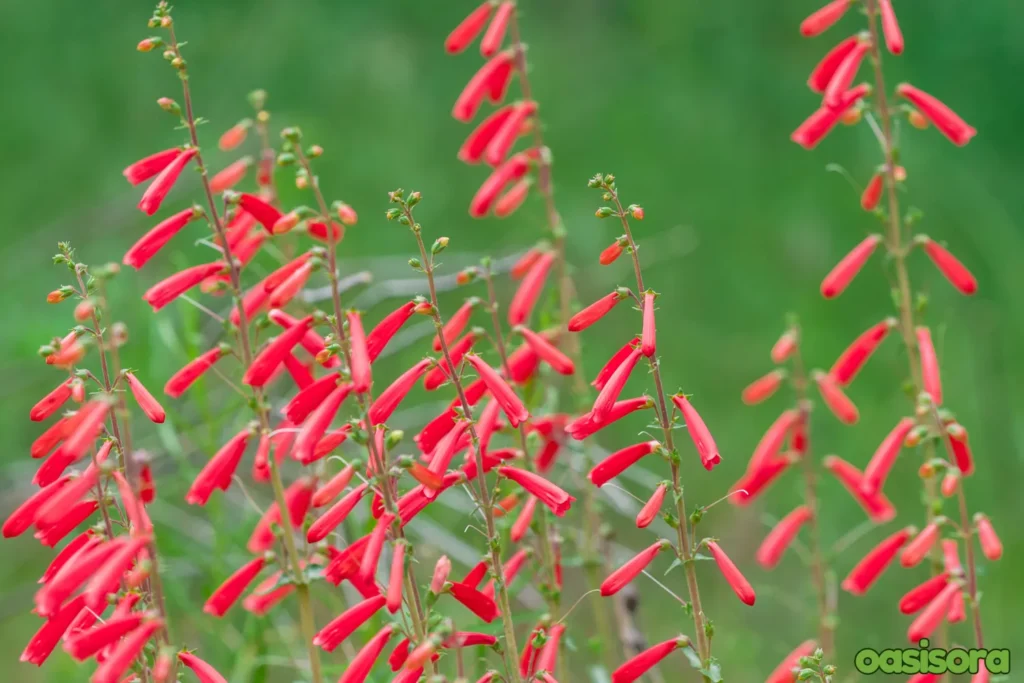
Scarlet Bugler
| Size: | 3-6 ft. tall, 2-3 ft. wide |
| Ideal Zone: | 5-9 |
| Type: | Perennial |
| Notable Feature: | Bright red, trumpet-shaped flowers that attract hummingbirds and butterflies |
Scarlet Bugler is a striking perennial that blooms from mid-spring to mid-summer with nearly perfectly symmetrical, brilliant crimson to orange-red flowers on rising stems. These matchless plants thrive well in dry or rocky sites. And the leaves of it are really beautiful, waxy, and gray in shade. It is native to Mexico and California and is ideal for low-water, Mediterranean, and rock gardens. It adds a beautiful sparkle to your landscape!
23. California Fuchsia (Epilobium canum)
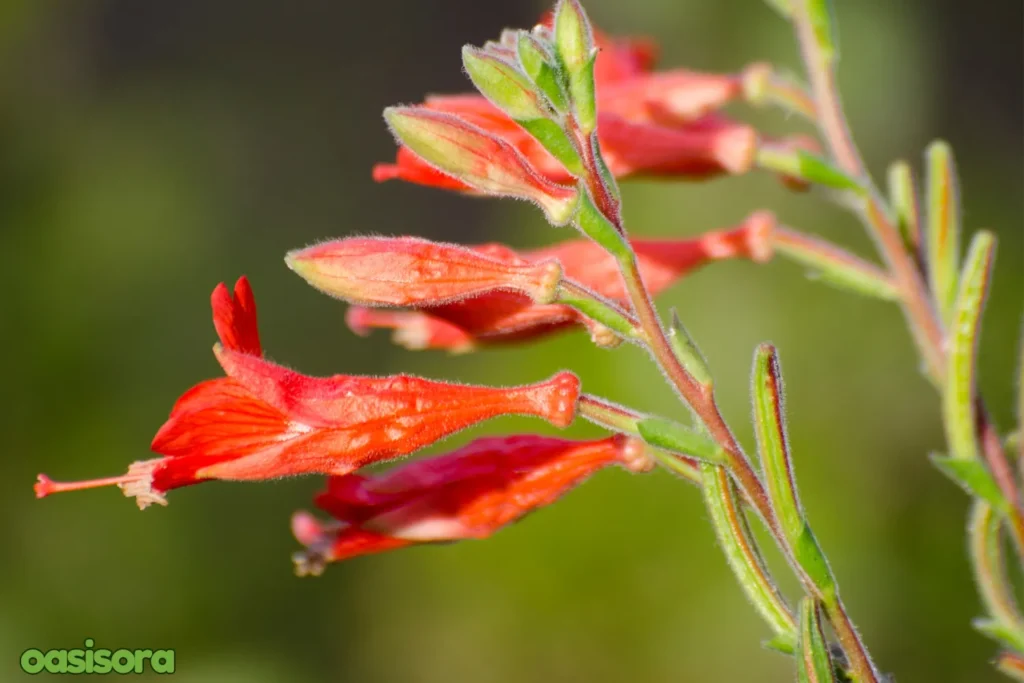
California Fuchsia
| Size: | 2-4 ft. tall, 3-6 ft. wide |
| Ideal Zone: | 8-10 |
| Type: | Perennial |
| Notable Feature: | Bright red, tubular flowers that attract hummingbirds and butterflies |
The other Drought-Resistant Plants for California Yards are California Fuchsia aka Wild Fuchsia, Firechalice, Kolibritrumpet, Zauschneria californica, and Zauschneria microphylla. This is a spreading, low-growing, semi-evergreen perennial that is adorned with narrowly lance-shaped, grayish-green leaves with a velvety touch. It loves sunshine and has pretty red flowers. Even hummingbirds enjoy them! It requires very little water and is simple to grow.
Simply provide them with some water and sunlight. After it blooms, trim it back to ensure a robust regrowth next year!
24. Matilija Poppy (Romneya coulteri)
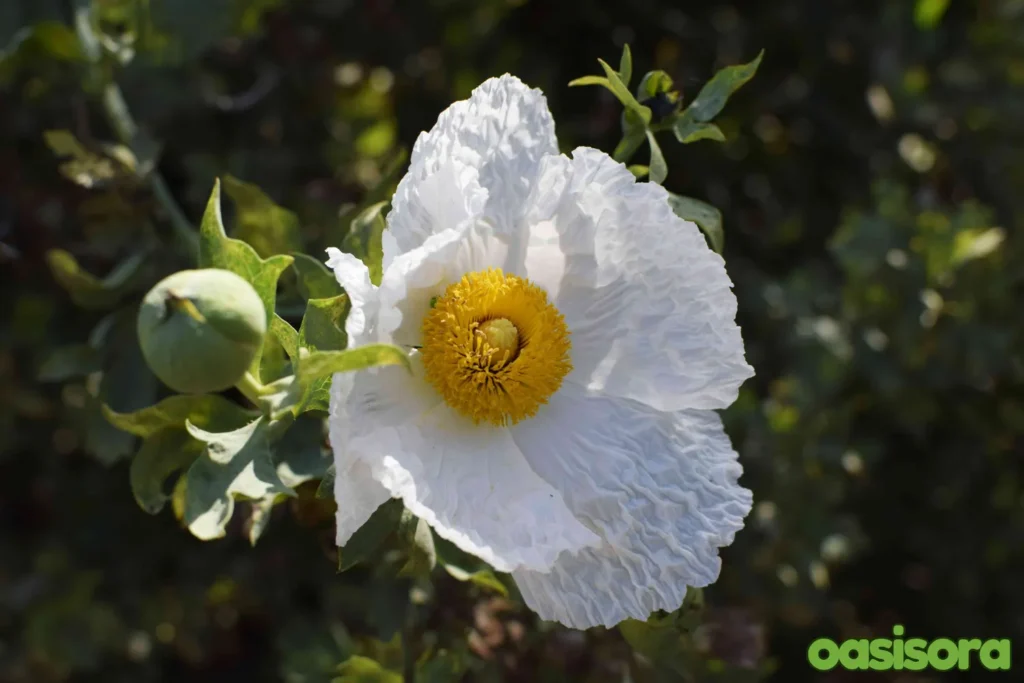
Matilija Poppy
| Size: | 6-9 ft. tall, 6-8 ft. wide |
| Ideal Zone: | 9-11 |
| Type: | Perennial |
| Notable Feature: | Large, showy white flowers with bright yellow centers |
You will love the Look of Matilija Poppy’s Amazing Flowers! Vigorous and bushy, Romneya coulteri is a spectacular flowering perennial covered with apricot-scented, large flowers. Each flower has 5-6 delicate, crinkly white petals that look like crepe paper! In the middle, there’s a bright yellow ball that shines like a tiny sun. The stems of it are strong and have beautiful gray-green leaves with fancy edges.
This lovely California plant blooms in late spring and summer, and then takes a rest in the fall.
25. Lavender (Lavandula spp.)
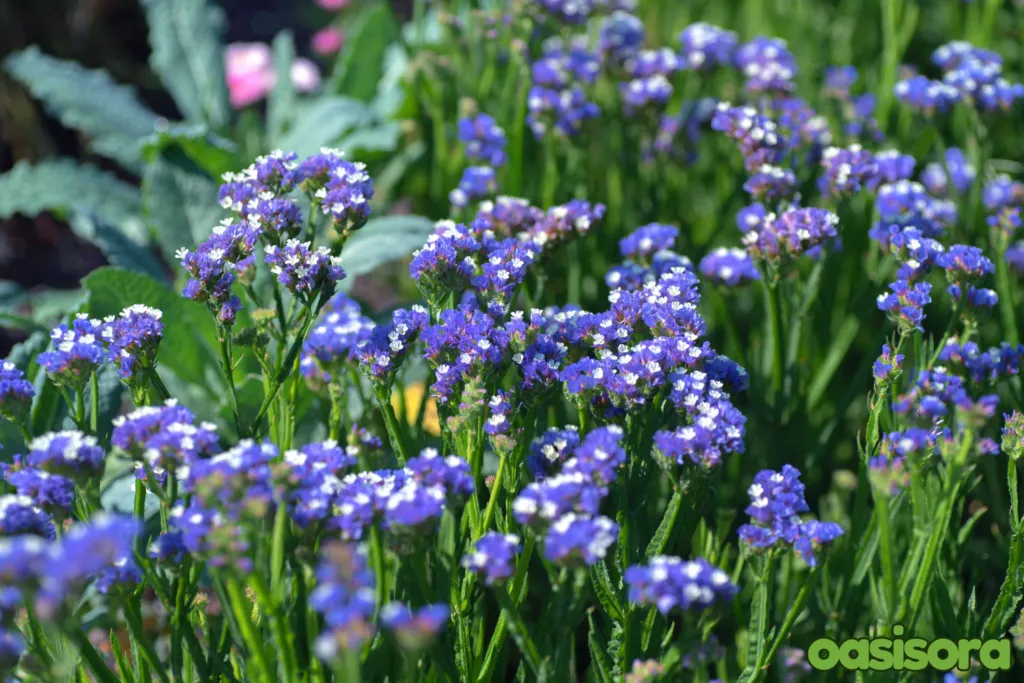
Lavender
| Size: | 1-3 ft. tall, 2-4 ft. wide |
| Ideal Zone: | 5-9 |
| Type: | Perennial |
| Notable Feature: | Fragrant purple flowers, silvery-gray foliage, and attracts pollinators |
Do you always need your yard to smell awesome? Then, lavender is your solution. This plant is cool! Its leaves are very skinny and smell amazing. They’re green on top and fuzzy white on the bottom. It’s easy to take care of. Just give it a little water, lots of sun, and good soil. Then, in the summer, it grows pretty purple or blue flowers. Butterflies love them! Plus, this versatile flower offers these uses:
- Aromatherapy- Calms and relaxes
- Perfumes & Cosmetics- Smells good!
- Herbal Medicine- Helps in feeling better
- Culinary- Adds flavor to food
- Ornamental- Pretty garden plant
Ornamental Grasses
Here we will discuss all about the Ornamental grasses for Japanese gardens:
26. Deer Grass (Muhlenbergia rigens)

Deer Grass
| Size: | 3-5 ft. tall, 3-4 ft. wide |
| Ideal Zone: | 7-10 |
| Type: | Warm-season perennial bunchgrass |
| Notable Feature: | Drought-tolerant, deer-resistant, and attractive fountain-like foliage |
Deer Grass, aka Meadow Muhly, Deer Muhly, Epicampes rigens, Muhlenbergia marshii, and Muhlenbergia mundula are included in the most beautiful and strong plants. It grows in bunches with thin, pointy leaves that are bright green to pale silver-green. The leaves stand up straight, then bend down, making an attractive fountain shape. In the fall, it grows thin yellow or purple flowers. Deer Grass is excellent for hot and dry places is too easy to care for and doesn’t need much water. It’s a good choice for gardens that want to save water.
27. Blue Fescue (Festuca glauca)
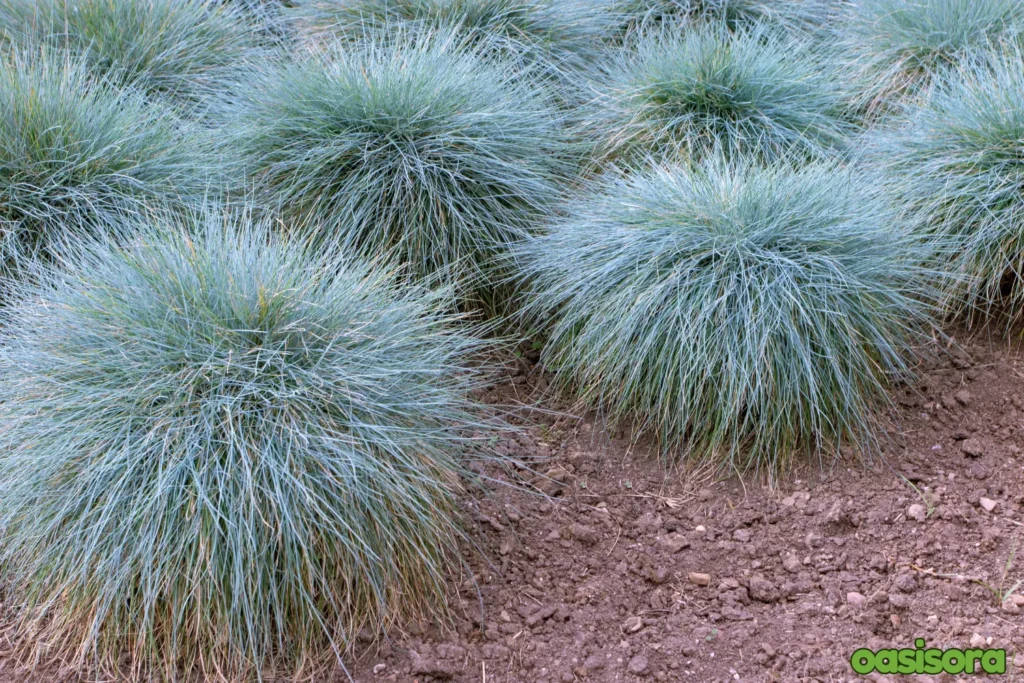
Blue Fescue
| Size: | 4-10 in tall, 4-10 in wide |
| Ideal Zone: | 4-8 |
| Type: | Cool-season clumping grass |
| Notable Feature: | Striking blue-gray foliage and drought tolerance |
My other top list of drought-resistant plants for California yards is blue fescue…..blue… everyone’s favorite hue. And in the yard, it looks more stunning and royal! Isn’t it? Blue Fescue, also known as Elijah Blue, Festuca Ovina glauca, and Festuca Ovina glauca, is a big and small ornamental grass. Due to the vivid silver-blue leaves that usually stay green all year round, it is highly adored. The leaves of this plant are thin like needles and grow close to form a very compact mound. In summer, tall flower spikes emerge above the leaves.
The flowers start becoming blue and then turn light brown. Blue Fescue looks remarkable when planted in groups and adds a pop of color to your landscape.
28. Buffalo Grass (Bouteloua dactyloides)
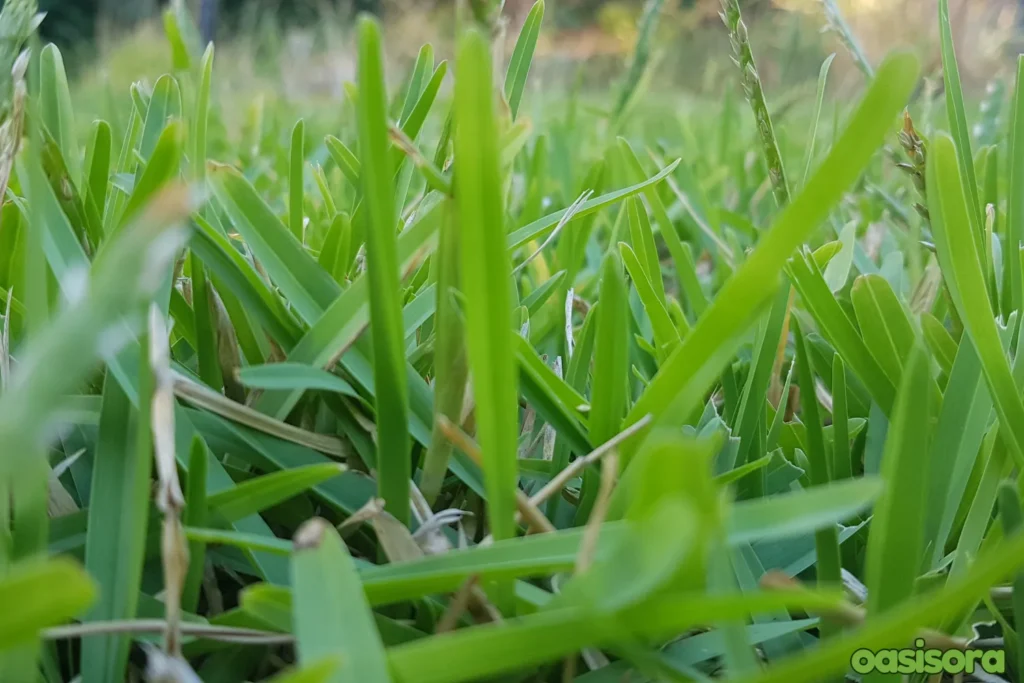
Buffalo Grass
| Size: | 2-3 ft. tall, 3-6 ft. wide |
| Ideal Zone: | 4-9 |
| Type: | Warm-season perennial grass |
| Notable Features: | Low water requirements, fine-textured foliage, and drought tolerance |
Buffalograss is a unique grass, which is soft and gray-green, and it grows in warm places and takes so little water to survive and thrive. Hence, it’s so much loved among ornamental grasses. The curled leaves and closely spaced stems of buffalograss. It’s so flawless for lawns because it’s low maintenance and can handle drought effortlessly. It even grows well in areas with very little rainfall!
29. Purple Needle Grass (Stipa pulchra)
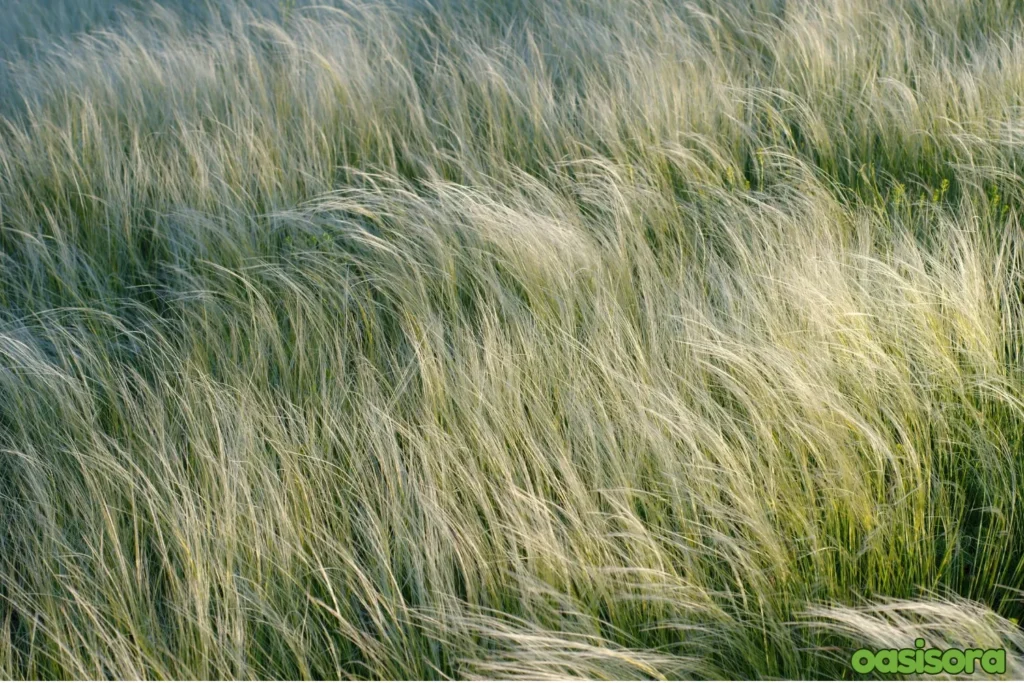
Purple Needle Grass
| Size: | 2-3 ft. tall, 1-2 ft. wide |
| Ideal Zone: | 6-10 |
| Type: | Cool-season perennial grass |
| Notable Feature: | Attractive purple flowers and needle-like foliage |
Purple Needlegrass is also included in special Drought-Resistant Plants for California Yards. It’s the state grass! It got its name from the purple color of its young seeds. Purple Needlegrass is a strong and handsome grass with deep roots that help it survive with little water. This makes it great for stopping soil erosion. Plus, it’s easy to grow, likes sunny spots, and produces seeds that attract birds and wildlife.
30. Sedge (Carex spp.)
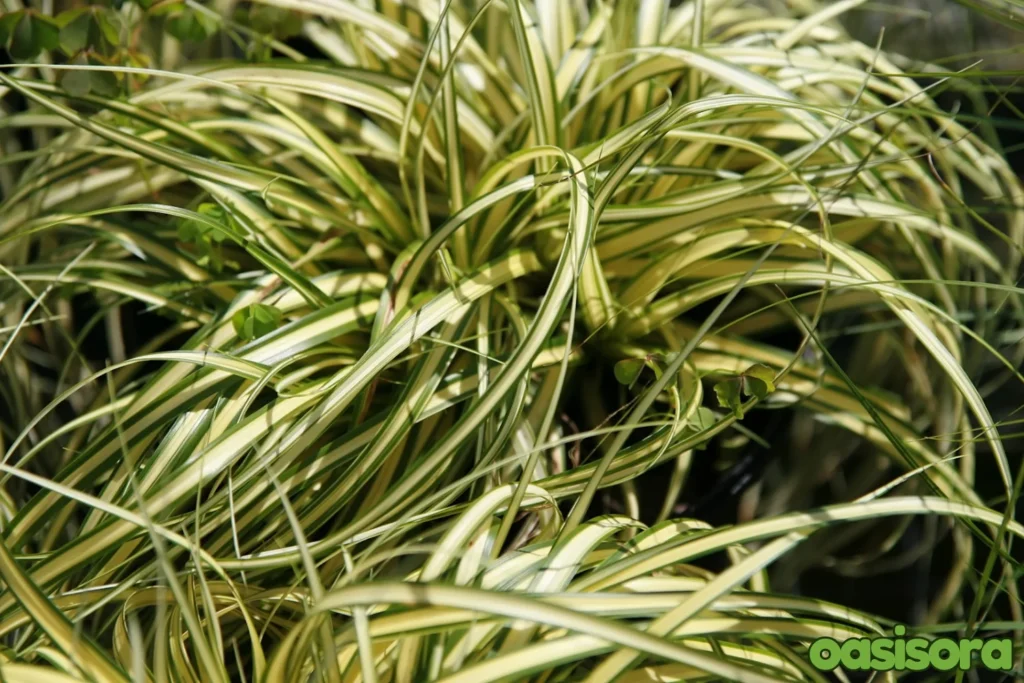
Sedge
| Size: | Varies by species |
| Ideal Zone: | Varies by species |
| Type: | Perennial grass-like plant |
| Notable Features: | Low maintenance, shade tolerance, and attractive foliage |
Sedge- mostly evergreen, shady, and drought-resistant plants for California yards. It can also be a great addition to your garden. There are actually over 1,500 ornamental grass species to choose from, depending on the conditions of light, water, or soil your garden has to offer. Such plants have their stylized leaves and stems. That makes them beautiful points in the garden. You can put it in borders, containers, or even water gardens. There’s a type of Sedge for almost any garden!
Best Practices for Landscaping with Drought-Resistant Plants in California
For gardeners, California’s dry climate can be difficult. However, you may create a stunning and sustainable environment with the use of correct plants and practices. Here’s how:
Planting Techniques:
Follow these effortless tips for planting drought-resistant plants for California yards:
Plant in the cooler months:
Fall and winter are the best times to plant in California.
Water deeply but infrequently:
Encourage deep root growth by watering your plants deeply, but less often.
Mulch around plants:
You can also use Organic Mulch or Bark dust to control soil temperature, invade weed growth, and help conserve soil moisture.
Preparing the Soil:
Now, for soil mix consider these tips:
Check your soil:
Test its type and pH level to choose the right plants.
Add organic goodness:
Mix in compost or well-rotted manure to boost soil fertility and structure further.
Use drought-tolerant soil mix:
Make a soil mixture that holds moisture and drains properly.
Xeriscaping: Grouping Plants with Similar Water Needs
My friends grow a gorgeous garden without draining your water resources by using this amazing technique of xeriscaping:
Group plants by water needs:
Sort plants into zones according to water needs.
Select plants that can withstand drought:
For this, you can choose plants that do well in arid environments, like native California plants and succulents.
Deliver Water Directly to the Roots by Using:
- Drip irrigation (like a personal water bottle for each plant!)
- Smart controllers (like a thermostat for your water usage!)
So, design beautiful and sustainable landscapes by adhering to these best practices and using the best drought-resistant plants for California yards to save water.
Watering Tips for Drought-Resistant Yards
It can be a little hard to water your drought-resistant yard, but if you know the right tricks, you can save water and maintain the health and happiness of your plants. The following are effective irrigation techniques and advice on how frequently to water your drought-resistant plants for California yards:
Efficient Irrigation Methods
Evaporation and runoff from typical sprinkler systems can cause too much wastage of water. Instead, consider using:
Drip irrigation systems
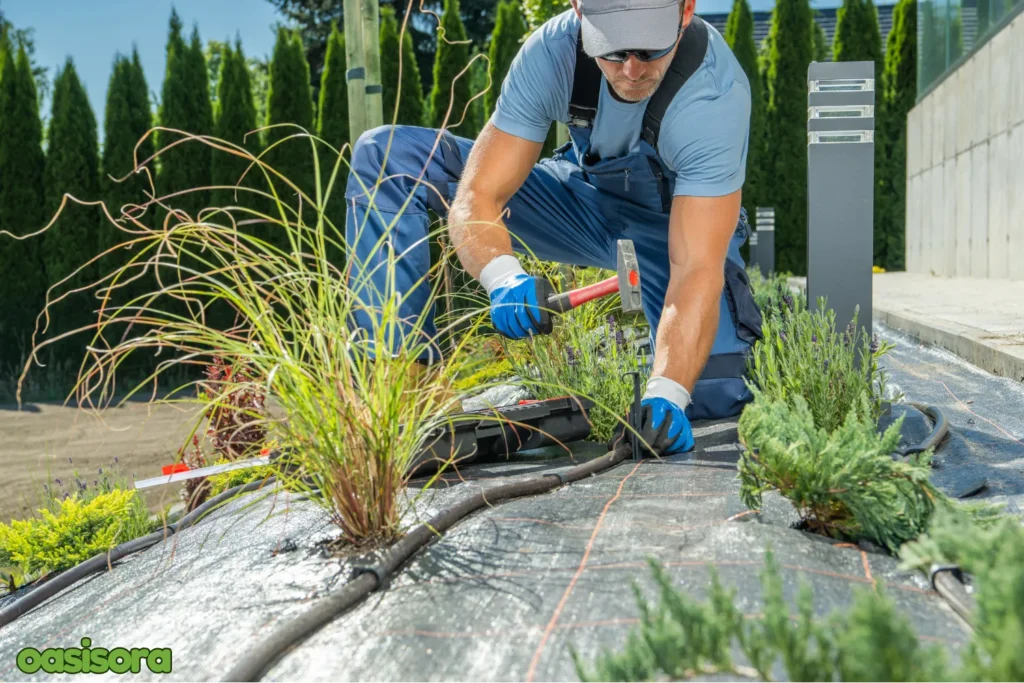
Drip Irrigation System
Drip irrigation is one of the best methods to water your plants. By supplying water directly to the roots of plants, these remarkable systems lessen runoff and evaporation.
How it works:
Drip irrigation works by:
- Water flows through tubes
- Small holes release water drops
- Drops fall straight to the roots
Soaker hoses
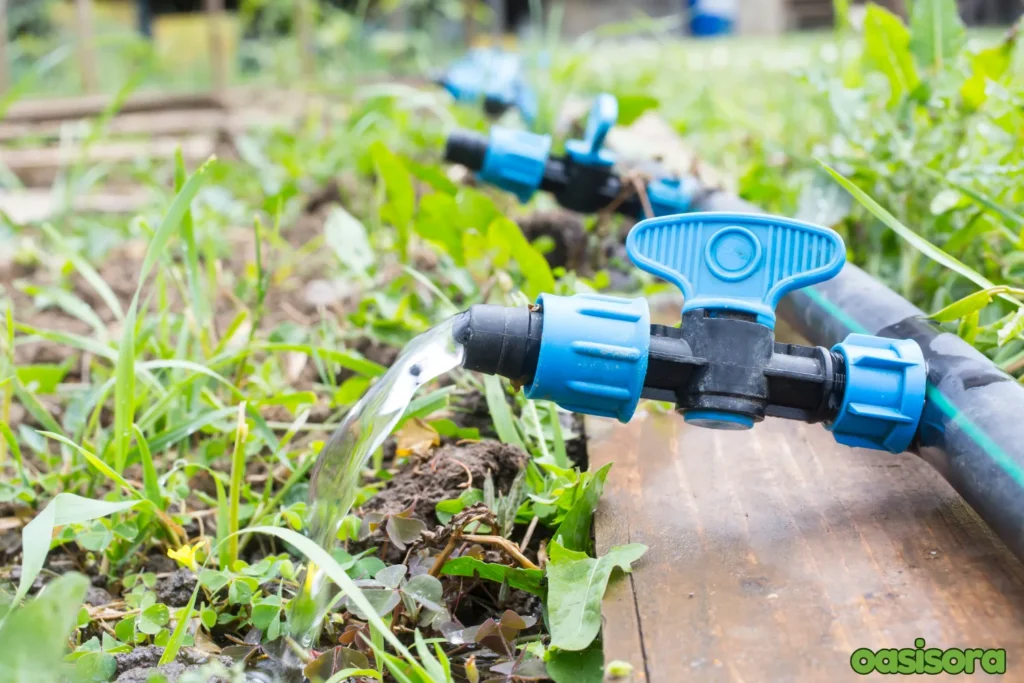
Soaker Hoses
Plants receive a constant supply of water due to the hose’s gradual and uniform water discharge.
How it works:
Soaker hose works by:
- Water flows in
- Tiny holes release water slowly
- Water seeps into the soil, reaching roots
How Often to Water Drought-Tolerant Plants?
Indeed drought-tolerant plants use less water to thrive, but they still need minimal moisture to survive and flourish. Here’s an easy guide on watering time and ways:
- Water deeply but infrequently
Water your plants 1-2 times a week Instead of watering daily. This will promote drought tolerance ability and also provide strong, deep roots.
- Checking the moisture level
Insert your finger into the soil to check its moisture content. If it feels:
Dry: Time to water!
Damp: Wait for another day or time before watering it again.
Note: Water early in the morning or at night. Do not water during the hottest portion of the day to reduce evaporation.
Additional Tips
Here I have gathered some extra tips for you guys. These tips will help you care for your drought-resistant plants for California yards more effectively:
Group plants by water needs
Separate your plants into zones based on their water requirements.
Avoid overwatering
Drought-tolerant plants are susceptible to root rot and other problems if the soil is too wet.
Monitor weather conditions
Adjust your watering schedule to the weather. You might not need to water your plants for a time if it has been raining. Let them inhale nature’s bliss!
By following these simple yet efficient irrigation methods and watering tactics, you can keep your drought-resistant yard healthy, lovely, and sustainable always.
Benefits of Drought-Resistant Plants for Wildlife and Pollinators
These amazing drought-resistant plants for California yards not only excel in dry conditions but also attract insects, birds, and pollinators that are beneficial. Here are 7 perks of drought-resistant plants:
1. Bee Friends
These flowers attract busy bees and provide them with food. This helps keep the bees happy and healthy.
2. Hummingbirds Haven
Tiny birds are drawn to sweet treats and cozy spots on these flowers that offer them a perfect place to rest.
3. Butterfly Bliss
Colorful flowers attract beautiful butterflies and provide them with food. They help these lovely creatures thrive. Isn’t it adorable!
4. Birds home
Such trees and shrubs provide a home for many birds. They offer shelter, food, plus a place to raise their young ones.
5. Insect Attractors
Certain drought flowers attract helpful insects that keep gardens healthy. These insects are a gardener’s best friend and offer good bacteria to plants to flourish.
6. Soil Health Boost
These special plants help keep soil healthy and strong and help add nutrients and prevent erosion.
7. Low Maintenance
Drought-resistant plants require little watering, pruning, plus fertilization.
Conclusion:
Transform Your California Yard with Water-Wise Plants
Are you ready to transform your Californian yard? Then, plant drought-resistant varieties in your yard! With them, you can create a beautiful yard that’s also good for the environment. These plants help you save water and time.
They’re excellent for California’s dry weather. You’ll save time and money on your water bill due to these plants being made to thrive with little watering. Plus, you won’t have to spend hours pruning and taking care of them because they’re frequently low-maintenance. The best thing, isn’t it?
Not only this? These plants do even more good things. They help nature and animals, keep your air clean, and prevent soil from washing away. Plus, you can also choose from many varieties of such beautiful plants to create a garden that’s both pretty and good for the environment.
So, why not switch to these plants that use less water? In addition to helping the environment, you will also get to cherish a lovely, low-care yard that will prosper for many years to come. Start transforming your yard today with remarkable drought-resistant plants for California yards and enjoy the incredible perks of these plants.

2 thoughts on “Top 30 Drought Resistant Plants for California Yards”
Comments are closed.